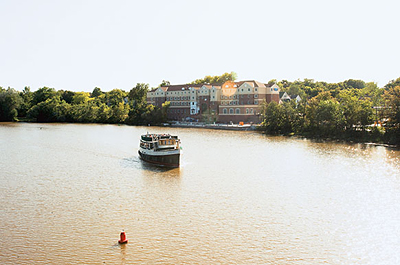

Community Connections
Beside . . . Across . . . and Along the Genesee
Projects along the Genesee are designed to bring the University and the City of Rochester closer together.

RIVER SCENE: Brooks Landing, a hotel and retail development, opens this fall across the Genesee from the River Campus.
By Kathleen McGarvey
For 25 years, the City of Rochester and the University have envisioned a development along the Genesee River that would fortify the links between the campus and its riverside neighbors in Rochester.
This fall, that vision takes shape with the opening of Brooks Landing, a hotel and retail development designed to tie the University closer to the neighborhoods near Plymouth Avenue and Exchange Street on the west side of the Genesee. Joined to the University by the River Campus footbridge, the complex includes an 88-room Staybridge Suites hotel. An office building and retail space are under construction, and a restaurant is expected to follow.
“This is a very concrete way in which we are connected to the community,” says Ronald Paprocki, the University’s senior vice president for administration and finance and chief financial officer. The project is the work of a private developer, Christenson Corp. of Minneapolis.
The University will lease space in the office building, which is slated to open in the spring of 2009. The Human Resources employment office and the Finance Department—about 100 University employees—will relocate to the building.
“The stumbling blocks” that have stood in the way of construction the past few decades “were developers’ concerns about the market and the various levels of government approvals that were necessary,” Paprocki says. “A small piece of land needed to be removed from parkland status . . . and that took years.”
Visions for Brooks Landing evolved over years, but the project began to take its final form under the administration of former Rochester Mayor William Johnson and continued under Mayor Robert Duffy. Ground was broken at the beginning of Joel Seligman’s presidency.
The planning efforts were themselves a community effort, involving the participation of the Sector 4 Community Development Corp.—a not-for-profit organization dedicated to building partnerships among community, business, and neighborhood groups in the southwest part of Rochester—the 19th Ward Community Association, the Plymouth-Exchange Neighborhood Association, the city, and the University.
“With the new waterfront development, the University and the city will both see benefits,” Paprocki says.
“It’s important for the University to have vibrant neighborhoods nearby. We’re embedded in the city, and what we want are stable neighborhoods where faculty, staff, and students would want to live.” Such proximity can have ripple effects, he points out. Employees and students who live near campus can walk to work or class, alleviating the strain on campus parking and contributing to improved sustainability practices.
“It also puts us in the position of being good neighbors,” Paprocki adds, noting that a university’s relationship to its surrounding community is unique. “Unlike companies, which may relocate, we are here to stay.”
The employment center will be accessible by public transportation, the hotel will provide lodging convenient to the Medical Center and to the River Campus for visitors to the admissions office, reunion events, and other departments, and the retail facilities and a new coffee house will draw students and University employees.
“We believe that in providing these facilities off campus, we’ll complement the space on campus for new teaching, research, health care, and student activities,” says Ron Christenson, the developer of Brooks Landing, who first came to investigate the site’s potential in 1999. “The University, on the other hand, has the opportunity to provide services, jobs, tutoring, and entrepreneurial initiatives to the community. We want to be a part of that program.”
Rochester City Councilmember Dana Miller ’89S (MBA), who was a member of the committee that first began to explore the project in the early 1980s, is now board chair of the Sector 4 Community Development Corp., which developed the coffee house.
“Brooks Landing provides a focal point,” Miller says. “We see it as a destination within the community. With this major development activity, people are looking at the area differently now, seeing it as an area with a lot of potential.”
Says Paprocki: “Part of the benefit to the neighborhood is the catalytic effect these projects have. One development can beget another.” Christenson, for example, is investigating construction of a condominium complex adjacent to Brooks Landing.
“This area has a tremendous number of amenities: the river, the new boardwalk, Genesee Valley Park, the University, and strong neighborhoods,” says Miller. “There really is a lot of opportunity for future growth.”
“One of the things we are seeing is a lot of activity in the neighborhood, which is beneficial for the city and the University,” Paprocki says.
